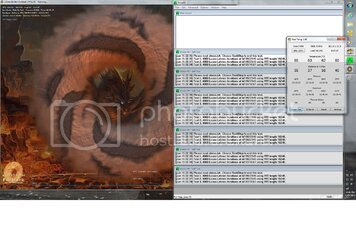- Joined
- Nov 20, 2007
- Location
- Fburg, VA
Welcome to Overclockers Forums! Join us to reply in threads, receive reduced ads, and to customize your site experience!

Sorry to say, heat doesn't rise.
Heat actually doesn't rise. Air, metals, liquids become lighter with heat because the material expands. In a block of iron, the heat radiates equally outward in all directions. Since the metals are bound together, the hotter molecules can't rise.
Fluids are different because the molecules are lightly bound and as they heat up, the mass becomes lighter, more space between the molecules due to more energy. And air is a fluid. Thus the heavier air goes down. Not the warmer air, the heavier air. So the light air has to rise to make room for the heavier air.
In a forced air situation it doesn't matter. You reverse your fans, you'll see a slight increase in CPU/GPU temps because warmer air will go through the rad.
Mmm, I am not sure that blowing the hot air from inside the case through the rad is a good idea. External temp is usually much lower than internal.

I'd switch them. In general the air is going to be warmer going into your radiator after passing through the case but the warmer air leaving the case will rise. As you have it now there is the potential for the warm air coming out the bottom to be sucked right back into the top as it rises. You could get a "thermal short circuit" the way they are now. Reversed there would be less chance as the hot air rises away.
The physics behind "heat rising" is that things in a system always go in the direction of equal or increasing entropy "The Second Law of Thermodynamics". But that is off topic.
Sorry to say, heat doesn't rise.
Heat actually doesn't rise. Air, metals, liquids become lighter with heat because the material expands. In a block of iron, the heat radiates equally outward in all directions. Since the metals are bound together, the hotter molecules can't rise.
Fluids are different because the molecules are lightly bound and as they heat up, the mass becomes lighter, more space between the molecules due to more energy. And air is a fluid. Thus the heavier air goes down. Not the warmer air, the heavier air. So the light air has to rise to make room for the heavier air.
In a forced air situation it doesn't matter. You reverse your fans, you'll see a slight increase in CPU/GPU temps because warmer air will go through the rad.
So if heat doesnt rise then how do hot air balloons work? And why is the middle floor always cooler than upstairs?
I think i proved my point...
For my part I saw it as an exercise in precise language. Heat doesn't rise but hot air does. Heat goes from 'hot' to 'not so hot'. Hot air is less dense than cooler air so there is a bouyant effect which most people would phrase as hot air rises. Which is shortend into "heat rises". But this is all academic in my opinion. But still fun.So if heat doesnt rise then how do hot air balloons work? And why is the middle floor always cooler than upstairs?
I think i proved my point...

Testing first - always a good idea!Well maybe ill reverse all the fans tonight and see what temps look like.
First Ill do a couple of tests with the current setup.


